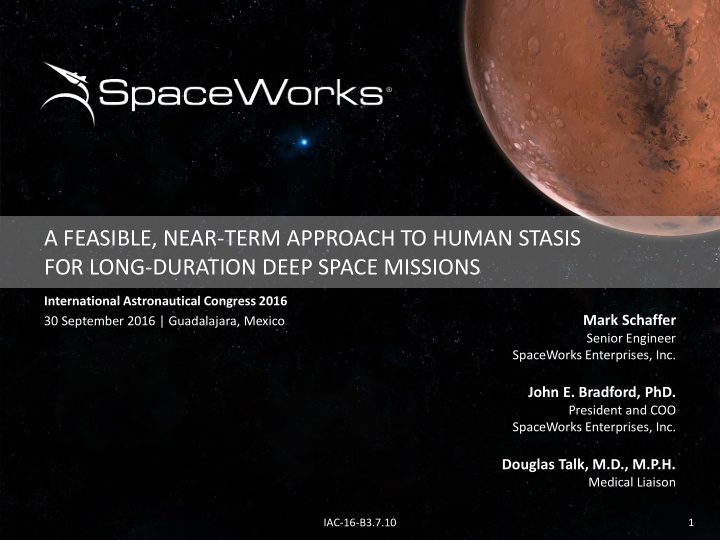



A FEASIBLE, NEAR-TERM APPROACH TO HUMAN STASIS FOR LONG-DURATION DEEP SPACE MISSIONS International Astronautical Congress 2016 Mark Schaffer 30 September 2016 | Guadalajara, Mexico Senior Engineer SpaceWorks Enterprises, Inc. John E. Bradford, PhD. President and COO SpaceWorks Enterprises, Inc. Douglas Talk, M.D., M.P.H. Medical Liaison IAC-16-B3.7.10 1
CONCEPT Place crew in inactive, low-metabolic Torpor state for deep space mission transit phases by expanding current medical practices in Therapeutic Hypothermia to support Prolonged Hypothermic Stasis and Metabolic Suppression. IAC-16-B3.7.10 2
RATIONALE • Significant decrease in mission consumables due to inactive crew and reduced metabolic rates • Large reduction in pressurized volume and size of radiation protection systems required for habitation and living quarters • Eliminate many ancillary crew accommodations such as food galley, eating supplies, exercise equipment, entertainment, etc. • Minimize psychological and social challenges for a crew in a confined environment for long durations • Potentially solves or mitigates a number of health issues with human spaceflight IAC-16-B3.7.10 3
THERAPEUTIC HYPOTHERMIA • Common medical practice for the treatment of Cardiac Arrest, Neonatal Encephalopathy, and other conditions • Involves actively cooling the body to 32-34°C for 48-72 hours • Sedatives administered to suppress shivering and induce sleep IAC-16-B3.7.10 4
THERMAL MANAGEMENT Effect of Body Temperature (°C) Evaporative Cooling Systems Normothermia 38° 36° Standard medical Shivering starts practice for Therapeutic 34° Hypothermia (TH) 32° Mild Hypothermia 30° 28° Threshold for 26° medical complications Moderate 24° Image Credit: Benechill Hypothermia 22° 20° 18° Deep Hypothermia 16° 14° Profound Hypothermia Image Credit: Advanced Cooling Technologies IAC-16-B3.7.10 5
NUTRITION AND HYDRATION • Nutrition and hydration can be Pinnacle System™ for automated TPN management provided intravenously through Total Parenteral Nutrition (TPN) – Mixture of lipids, amino acids, dextrose, electrolytes, vitamins, and trace elements – Bypasses the usual process of eating and digestion Image Credit: B. Braun Medical Inc. – Routinely administered to patients recovering from an accident, surgery, or digestive disorder NASA IVGEN System for in-space purification of IV-grade water • Metabolic suppression via torpor is likely to reduce consumables mass requirements by 30%-60% Image Credit: NASA IAC-16-B3.7.10 6
MEDICAL ADVANTAGES OF TORPOR • TH has recently been recommended as a standard treatment for reducing increased intracranial pressure in hospitals • Recent medical testing on comatose patients indicates that neuromuscular electrical stimulation (NMES) can prevent muscle atrophy due to disuse • Stationary crew simplifies implementation of induced artificial gravity through rotation to combat bone demineralization • Some medical studies have indicated the potential for reduced damaging effects of radiation on animals when cooled IAC-16-B3.7.10 7
IMPLEMENTATION IN SPACE Body Cooling Body Warming Thermal management Thermal pads system inserted through nasal cavity Health Monitoring Sensor leads across body (e.g. 12-lead ECG) TPN administration Tunneled central venous catheters in chest and leg Waste Collection Urine collection catheter and drain line IAC-16-B3.7.10 8
STUDY STATUS • In 2013, conducted a Phase I study from NASA NIAC program to study feasibility of using torpor to support human exploration missions to Mars • Received Phase II funding from NASA NIAC in summer to continue medical and engineering analysis • Assembled a team of medical researchers to study biomedical aspects of concept • Currently pursuing additional funding, from both private sources and government, to initiate preliminary medical evaluations IAC-16-B3.7.10 9
NASA NIAC PHASE II STUDY 1. Medical Assessments and Evaluations 2. Mars Mission Habitat Designs • • Nutrition and intravenous support Habitat internal thermal environment analysis • Metabolic suppression approaches • Radiation shielding assessment • Prolonged hypothermia physiological • impacts Crew concept of operations • • Evaluation of prolonged hypothermia Torpor habitat design refinement in non-hibernating mammals • Hypothermia induction process and supporting hardware systems 3. Extensibility Beyond Mars 4. Technology Roadmap Development • • Martian moons Identification of key challenges • • Main belt asteroids Maturation costs • • Jupiter and Saturn systems Near-term and long-term development roadmaps IAC-16-B3.7.10 10
MEDICAL TEAM Doug Talk, M.D., M.P.H. Naval Air Station Lemoore, CA Medical Team Lead Departmental Director of Surgical Services Be Cool Pharmaceutics (BCP), LLC. Kelly Drew, Ph.D. Professor, University of Alaska Fairbanks Neuroscientist, Professor Department of Chemistry and Biochemistry, Institute of Arctic Biology (IAB) Mayo Clinic Alejandro Rabinstein, M.D. Medical Director of Neuroscience Intensive Care Unit Professor of Clinical Neurology (ICU) Matthew Kumar, M.D. Mayo Clinic Health System Albert Lea/Austin Asst. Professor of Anesthesiology Chair (Department of Anesthesiology) Leroy Chiao, Ph.D. ISS Expedition 10 Commander, STS-65/72/92 Missions Astronaut Doctorate in Chemical Engineering IAC-16-B3.7.10 11
KEY CHALLENGES • Maximizing stasis period. Current common practice is 2-3 days, more cases at 4-5 days, with some very limited cases at 14-days. • Mitigating known complications of TPN and hypothermia (thromboembolism, infection, fatty liver disease, etc.) • Developing procedures for addressing medical issues that could occur during transit with inactive crew, e.g. automated vs. human intervention • Addressing slow wake times that are currently required during warming • Uncertainty in effects of prolonged torpor on crew mental faculties IAC-16-B3.7.10 12
FINAL REMARKS • Therapeutic Hypothermia continues to appear as the most promising approach toward enabling human stasis. • Prolonged hypothermic stasis combined with metabolic suppression may provide a number of unique benefits and solve a variety of medical challenges for space travel • Our goal is to develop near-term and long-term technology development roadmaps to mature this concept for human spaceflight We believe this capability will be critical for sustaining human presence in space and ultimately settling the solar system IAC-16-B3.7.10 13
Engineering Today, Enabling Tomorrow SPACEWORKS ENTERPRISES, INC. (SEI) | www.sei.aero | info@sei.aero 1040 Crown Pointe Parkway, Suite 950 | Atlanta, GA 30338 USA | +1-770-379-8000
Recommend
More recommend